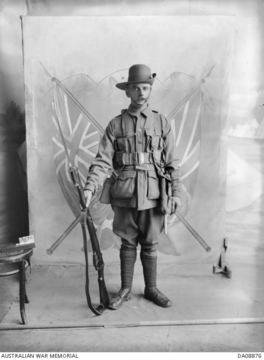HOWARD, George
| Service Number: | 558 |
|---|---|
| Enlisted: | Not yet discovered |
| Last Rank: | Private |
| Last Unit: | 23rd Infantry Battalion |
| Born: | Not yet discovered |
| Home Town: | Not yet discovered |
| Schooling: | Not yet discovered |
| Occupation: | Not yet discovered |
| Memorials: |
World War 1 Service
| 10 May 1915: | Involvement Private, 558, 23rd Infantry Battalion, --- :embarkation_roll: roll_number: '14' embarkation_place: Melbourne embarkation_ship: HMAT Euripides embarkation_ship_number: A14 public_note: '' | |
|---|---|---|
| 10 May 1915: | Embarked Private, 558, 23rd Infantry Battalion, HMAT Euripides, Melbourne |
Help us honour George Howard's service by contributing information, stories, and images so that they can be preserved for future generations.
Add my storyBiography contributed by Aubrey Bairstow
George Howard, an Aucklander who moved to Australia as a child, was one of a number of Victorians who enlisted for service in the Boer War with the 2nd Scottish Horse Regiment. He was allocated the rank of Trooper and the service number 31627. They departed Melbourne on the transport Orient on 15th February, 1901 bound for Cape Town. The group arrived on 8th March, 1901. George was allocated to "E Squadron" on six-month enlistment term. He was posted to 2nd's base at Middelburg on Pretoria-Delegoa Bay railway line. His first enlistment term expired on 14th September, 1901 so was discharged and returned to Melbourne. The QSA Medal roll states that he and others were discharged in Melbourne on or about 16 September 1901.
Private 561 George Howard, Boer War – 2nd Australian Commonwealth Horse (Victoria). Enlisted with the 2nd Australian Commonwealth Horse on 8th January, 1902 at Langwarrin, Victoria and allocated the service number 561. In his application he states that he was born in Auckland and that he was a 31 year old labourer from Fitzroy with 6 months prior service in the Scottish Horse. He gave his next of kin as his mother, also living in Fitzroy.
The 2nd ACH departed Melbourne on the transport St Andrew on 12th February arriving Durban 10th March,1902. They participated in the drive in early May through Joubert's Rust, Rapoli, Boesman's Pan, Wonderfontein and Karl Platts. The drive terminated at Veryburg on the Kimberly-Mafeking line. The unit captured 326 prisoners including Jan De La Rey, brother of the General. The contingent returned to Klerksdorp on 21st May and remained there after peace was concluded until 20th June. They departed Durban on the transport Norfolk on 8th July arriving at Melbourne on 2 August, 1902 and George was discharged the same day. For his service in South Africa he was awarded five QSA Clasps - Cape Colony, Orange Free State, Transvaal, South Africa 1901 and South Africa 1902 – the medal being named to the Scottish Horse and issued from England .
He stated to have served in New Guinea Expeditionary Force but was found to be medically unfit and so served for just over 40 days.
George enlisted at Melbourne on 24 February, 1915 as an original member of "C Company" 23rd Battalion aged 40 years and one month. His next of kin was still his mother, this time residing at East Brunswick. He embarked 8 May 1915 from Melbourne on HMAT A14 Euirpides arriving Egypt on 11 June, 1915. They landed at Gallipoli on 4 September, 1915 and manned Lone Pine and Brown's Dip. The 23rd Battalion departed Gallipoli with the remainder of the A.I.F. during 8th-20th December, 1915.
George and the 23rd entered the Western Front on 10 April, 1916 occupying forward trenches of the Armentieres sector, Northern France. The 23rd was involved in the horrific Battles of Pozieres and Monquet Farm in July, 1916. It is estimated that almost 90% of the original 23rd members were lost in these battles. The 23rd Battalion then manned the Front Line throughout the bleak winter of 1916-1917.
Howard was repatriated back to Australia on 8 April 1917 on the grounds of ill health. His medical record indicated he suffered from myalgia, rheumatics and over age. He was finally demobilised on 16 July, 1917 now aged 44 years and six months.
George moved to Bendigo where he died in 1947.









